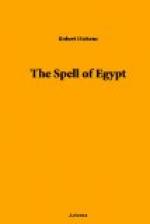In the museum of Cairo there is the mummy of “the lady Amanit, priestess of Hathor.” She lies there upon her back, with her thin body slightly turned toward the left side, as if in an effort to change her position. Her head is completely turned to the same side. Her mouth is wide open, showing all the teeth. The tongue is lolling out. Upon the head the thin, brown hair makes a line above the little ear, and is mingled at the back of the head with false tresses. Round the neck is a mass of ornaments, of amulets and beads. The right arm and hand lie along the body. The expression of “the lady Amanit” is very strange, and very subtle; for it combines horror—which implies activity—with a profound, an impenetrable repose, far beyond the reach of all disturbance. In the temple of Denderah I fancied the lady Amanit ministering sadly, even terribly, to a lonely goddess, moving in fear through an eternal gloom, dying at last there, overwhelmed by tasks too heavy for that tiny body, the ultra-sensitive spirit that inhabited it. And now she sleeps—one feels that, as one gazes at the mummy—very profoundly, though not yet very calmly, the lady Amanit. But her goddess—still she wakes upon her column.
When I came out at last into the sunlight of the growing day, I circled the temple, skirting its gigantic, corniced walls, from which at intervals the heads and paws of resting lions protrude, to see another woman whose fame for loveliness and seduction is almost as legendary as Aphrodite’s. It is fitting enough that Cleopatra’s form should be graven upon the temple of Hathor; fitting, also, that though I found her in the presence of deities, and in the company of her son, Caesarion, her face, which is in profile, should have nothing of Hathor’s sad impressiveness. This, no doubt, is not the real Cleopatra. Nevertheless, this face suggests a certain self-complacent cruelty and sensuality essentially human, and utterly detached from all divinity, whereas in the face of the goddess there is a something remote, and even distantly intellectual, which calls the imagination to “the fields beyond.”




